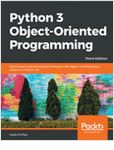 | Object-oriented programming (OOP) is a popular design paradigm in which data and behaviors are encapsulated in such a way that they can be manipulated together. This third edition of Python 3 Object-Oriented Programming fully explains classes, data encapsulation, and exceptions with an emphasis on when you can use each principle to develop well-designed software. What You Will Learn Implement objects in Python by creating classes and defining methods Grasp common concurrency techniques and pitfalls in Python 3 Extend class functionality using inheritance Understand when to use object-oriented features, and more importantly when not to use them Discover what design patterns are and why they are different in Python Uncover the simplicity of unit testing and why it's so important in Python Explore concurrent object-oriented programming By the end of the book, you will have thoroughly learned object-oriented principles using Python syntax and be able to create robust and reliable programs confidently. Request Free! |
